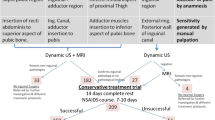Abstract
Background
Groin pain in athletes is caused by a wide range of musculoskeletal disorders. Occasionally, a palpable bulge at the external ring or ultrasound may not demonstrate a hernia. When athletes do not respond to conservative treatment, a “sports” hernia should be considered.
Methods
A retrospective review of 750 laparoscopic preperitoneal hernias was performed. A sports hernia was defined as a tear in the transversalis fascia that was not evident by preoperative physical exam. A 7 × 10-cm biologic mesh, Surgisis, was placed, uncut, over the myopectinate orifice and fixed with five tacks or fibrin glue. Patients were followed up at 2 and 6 weeks, 6 months, and 1 year.
Results
Ten professional and amateur athletes were found to have sports hernias. Operative time averaged 32 min. There were no major complications. All athletes returned to full activities in 4 weeks. Only one patient did not show improvement in his symptoms. No patient developed a recurrent hernia.
Conclusions
Laparoscopic exploration should be considered in athletes with chronic groin pain that does not improve after conventional treatments have failed. Furthermore, biologic mesh (Surgisis) should be considered for the repair of inguinal sports hernias.
Similar content being viewed by others
References
Badylak SF, Lantz G, Coffey A, Geddes LA (1989) Small intestinal submucosa as a large diameter vascular graft in the dog. J Surg Res 47: 74–80
Brooks DC (1994) A prospective comparison of laparoscopic and tension-free open herniorrhaphy. Arch Surg 129: 361–366
Clarke KM, Lantz GC, Salisbury SK, Badylak SF, Hiles MC, Voytik SL (1996) Intestinal submucosa and polypropylene mesh for abdominal wall repair in dogs. J Surg Res 60: 107–114
Edelman DE (2002) Laparoscopic herniorrhaphy using porcine small intestine submucosa—a preliminary study. J Soc Laparoendosc Surg 6: 203–205
Franklin ME, Gonzalez JJ, Glass JL (2004) Use of porcine small intestinal submucosa as a prosthetic device for laparoscopic repair of hernias in contaminated fields: 2-year follow-up. Hernia 8: 3–6
Hackney RG (1993) The sports hernia: a cause of chronic pain. Br J Sports Med 27: 58–62
Ingoldby CJ (1997) Laparoscopic and conventional repair of groin disruption in sportsmen. Br J Surg 84: 213–215
Kozol R, Lange PM, Kosir M, Beleski K, Mason K, Tennenberg S, Kubinec SM, Wilson RF (1997) A prospective, randomized study of open vs laparoscopic inguinal hernia repair. Arch Surg 132: 292–295
Liem MS, Graaf YV, Steensel CJ, et al. (1997) Comparison of conventional anterior surgery and laparoscopic surgery for inguinal hernia repair. N Engl J Med 336: 1541–1547
Morelli V, Smith V (2001) Groin injuries in athletes. Am Family Physician 64: 1405–1414
Orchard JW, Read JW, Neophyton J, Garlick D (1998) Groin pain associated with ultrasound finding of inguinal canal posterior wall deficiency in Australian rules footballers. Br J Sports Med 32: 134–139
Payne JH, Grininger LM, Izawa MT, Podoll EF, Lindahl PJ, Balfour J (1994) Laparoscopic or open inguinal herniorrhaphy? Arch Surg 129: 973–979
Prevel CD, Eppley BL, Summerlin DJ, Jackson JR, McCarty M, Badylak SF (1995) Small intestinal submucosa: utilization for repair of rodent abdominal wall defects. Ann Plastic Surg 35: 374–380
Srinivasan A, Schuricht A (2002) Long term follow-up of laparoscopic preperitoneal hernia repair in professional athletes. J Laparoendosc Advanced Surg Tech 12: 101–106
Taylor DC, Meyers WC, Moylan JA, Lohnes J, Bassett FH, Garrett WE (1991) Abdominal musculature abnormalities as a cause of groin pain in athletes. Am J Sports Med 19: 239–242
Tuite JM, DeSmet AA (1994) MRI of selected sports injuries: muscle tears, groin pain and osteochondritis dessecans. Semin Ultrasound CT MRI 15: 318–340
Voeller GR, Mangiante EC, Wilson C (1995) Totally preperitoneal laparoscopic inguinal herniorrhaphy using balloon dissection. Surgical Rounds 3: 107–112
Author information
Authors and Affiliations
Corresponding author
Rights and permissions
About this article
Cite this article
Edelman, D.S., Selesnick, H. “Sports” hernia: treatment with biologic mesh (Surgisis). Surg Endosc 20, 971–973 (2006). https://doi.org/10.1007/s00464-005-0281-8
Received:
Accepted:
Published:
Issue Date:
DOI: https://doi.org/10.1007/s00464-005-0281-8



